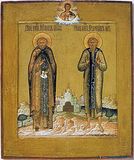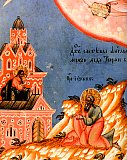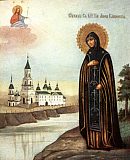

| Previous day | Next day |
| Old Style
July 21
|
Saturday |
New Style
August 3
|
| 6th Week after Pentecost. Tone 4. | No fast.
|
![]() Prophet Ezekiel (6th c. b.c.).
Prophet Ezekiel (6th c. b.c.). ![]() St. Symeon of Emesa, fool-for-Christ (590), and his fellow faster St. John (ca. 590).
St. Symeon of Emesa, fool-for-Christ (590), and his fellow faster St. John (ca. 590).
Martyr Victor of Marseilles (3rd c.). St. Onuphrius the Silent, of the Kiev Caves and St. Onesimus, recluse, of the Kiev Caves (12th c.-13th c.) Uncovering of the relics of St. Anna, princess of Kashin (Euphrosyne in monasticism) (1649). St. Arsenia (Sebryakova), abbess of the Ust-Medveditsk Convent (Volgograd) (1905). St. John of Tula, fool-for-Christ.
“Armatia” Icon of the Most Holy Theotokos.
Hieromartyr Zoticus of Comana in Armenia (204). Martyrs Justus, Matthew, and Eugene, at Rome (305). Hieromartyr Bargabdesian, deacon, at Arbela in Assyria (354). Sts. Paul, bishop, and John, priest, ascetics, near Edessa (5th c.). Sts. Raphael (1640-1645) and Parthenius (1660) of Old Agapia Monastery (Romania). St. Parthenius of Radovizlios, bishop (1777). New Hieromartyrs Simo Banjac and Milan Stojisavljevic, and the latter’s son Martyr Milan, of Glamoc, Serbia (1941-1945). St. Eleutherius of “Dry Hill”.
Repose of Abbot Gerasim of the Chudov Monastery (1911), Blessed Anthony Petrovich Shuvalov, wonderworker of Undor- Simbirsk (1942), and Abbess Euphemia of the Ravanica and St. Petka monasteries (Serbia) (1958).
Thoughts for Each Day of the Year
According to the Daily Church Readings from the Word of God
By St. Theophan the Recluse

Friday. [I Cor. 4:5-8; Matt. 13:44-54]
Arriving in Nazareth the Lord found no faith there. His visible simplicity hindered the Nazarenes from seeing His invisible glory and divinity. Does not the same occur with a Christian? Christian dogmas are very simple in appearance; but for the mind which enters into them, they represent an all-embracing harmonious system in and of themselves, which were not, nor ever could be generated by any creature’s mind. Proud-mindedness, casting a fleeting glance at the simplicity of the Gospels, is repelled by it and begins to build its own house of knowledge, which it deems enormous and full of broad horizons. It is in fact no more than a towering house of cards, and the horizons are no more than mirages, phantom products of a heated imagination. But there is no point in telling him. He and his brothers are ready with their critical attacks to immediately cast anyone from the mountain into the abyss who tries to dissuade them; but the truth always passes unharmed through their midst and goes on to other souls capable of receiving it.
Saturday. [Rom. 9:1-5; Matt. 9:18-26]
The woman with the issue of blood said: If I may but touch His garment, (the Lord’s), I shall be whole, and she received healing according to her faith. We, the sensual, need physical contact in order to receive intangible strength. The Lord arranged things this way. His holy Church has a visible structure. Its various parts embrace us and we touch them. The power of God, found inside the Church, is received through such contact by those who have a receiver—faith, which says: “If I may but touch, I shall be made whole.” The Church is the body and garment of the Lord. The most visible parts, which we touch, are the Divine Mysteries, particularly baptism and Chrismation, the Sacrament of the Lord’s Body and Blood in conjunction with the Sacrament of confession. But contact with all the other aspects can draw needed strength from the Lord, Who is everywhere. He sees each person who does this, and says to his heart, “Be bold, my child!” Free-thinkers, antagonistic toward the external rites of the Church, thus deprive themselves of the opportunity to enter into contact with the inner, divine, all-animating power. This is why they remain sick, and exhausting themselves with the flow of vain thoughts and feelings, they dry up spiritually and die.
Articles
 Prophet EzekielThe Holy Prophet Ezekiel lived in the sixth century before the birth of Christ. |








